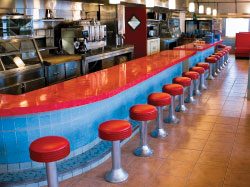
From lunch wagons to stone edifices, here’s a quick history of the structure you may be sitting in.
With a giddyup and a creak of wooden wheels, an enterprising Rhode Islander named Walter Scott launched the fast-food era in the late 1800’s. Factory workers in Providence lined up at his lunch wagon, and soon the meals-on-wheels concept spread through New England and south to New York and New Jersey. At some point the wheels came off, the horses went to the glue factory, utilities were connected, signs went up, and the aromas of coffee and frying bacon drew people into the cozy confines of the first diners.
Although a few old trolley cars were converted into eateries, the railroad-car diner was more a style than an actuality. (Even the earliest diners were wider than train cars.) From the 1920s to the 1980s, New Jersey had at least six and as many as twenty manufacturers churning out long, narrow, modular, railroad-style diners with curved roofs, squat windows, and enameled porcelain exteriors.
The state’s oldest surviving diner, Max’s in Harrison, was built in 1927 by the Jerry O’Mahony company of Elizabeth, which also made the Summit Diner in 1938 and the glitzy Miss America in Jersey City in the 1950s.
The honor roll of Jersey diner builders includes Fodero of Bloomfield (Manhattan’s 1946 Empire Diner; the 1940s Premium in Avenel); Mountain View of Singac (Big Ernie’s in Wildwood, 1950s); Silk City of Paterson (the 1945 Time Out in Tuckahoe); Paramount Modular of Oakland (the 1948 Blairstown, where scenes from Friday the 13th were filmed); and Kullman, originally of Avenel (the Club in Bellmawr, early ’60s; the Mastoris in Cherry Hill).
All are gone now except Kullman, which still builds the occasional diner (like the Red Hawk on the campus of Montclair State in 2000), but in recent decades has adapted its prefab manufacturing techniques to dorms, prisons, classrooms, restrooms, and even the American embassy in Guinea-Bissau.
Robby Kullman followed his father, Harold, and grandfather Samuel into the family business. The company, later sold, is now located in Lebanon. During the heyday of the modular diner, the manufacturers helped aspiring owners get off the ground in more ways than one. “We would finance them and build it,” Kullman says.
As in the automobile business, Kullman relates, “Each year, my father and grandfather would come up with new designs. From the 1940s through the 1960s, stainless-steel prefab diners changed a lot. If people were successful, they would build bigger ones. Or if they just wanted a new look. It was a really good business.”
Like tail fins on cars, the era of flamboyant diner design reached its apex in the 1950s. In the ’60s and ’70s, Kullman says, “the new diners were bigger and the owners wanted more permanence. Stainless steel went out and stone came in.” Costs skyrocketed. Pre-war diners were built for as little as $10,000 to $30,000. By the ’70s, the new, stone, colonial-style diners cost in the neighborhood of $200,000.
“You want to put up a 200-seat diner to compete today, that will be $2 million for the land and that again for the building,” Kullman says. “It just isn’t the same business.”
Click here for a list of the 25 best restaurants in NJ.
Click here to view our reader’s poll of the best restaurants.
Click here for detailed restaurant reviews of select venues.



